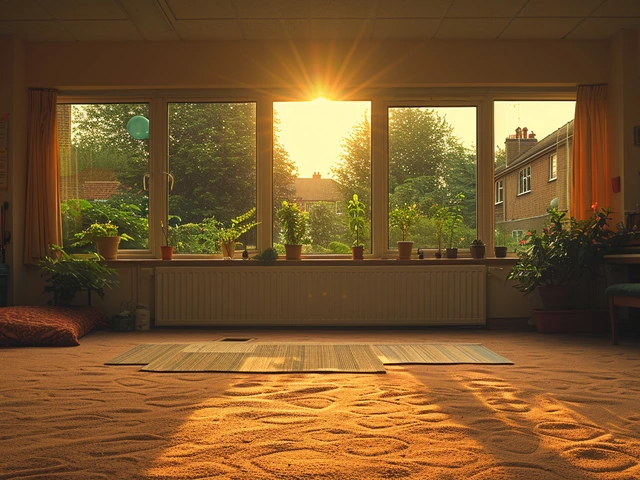Mindfulness isn't just a buzzword; it's a powerful practice that can transform your day-to-day experience. By bringing your attention to the present moment, you can enhance your well-being and stay grounded amidst life’s chaos. Let's explore how to effortlessly weave mindfulness into your daily routine with five practical steps.
First, let’s understand what mindfulness really is. It’s about being fully present and engaged in the here and now, without getting overwhelmed by thoughts about the past or future.
- Understanding Mindfulness
- Start with Breathing Exercises
- Mindful Eating
- Create a Mindfulness Trigger
- Set Aside Time for Meditation
Understanding Mindfulness
Mindfulness is not a new concept; it has roots in ancient meditation practices, particularly those of Buddhist origin. At its core, mindfulness is about being fully aware of your present moment, accepting it without judgment. It's not about emptying your mind or stopping thoughts but experiencing them as they come, without getting caught up in them.
Our modern lives are full of distractions. We’re often either stuck in the past or worrying about the future, which can lead to unnecessary stress and anxiety. Mindfulness helps break this cycle by encouraging us to focus on the now. Scientific studies have shown that regular mindfulness practice can reduce symptoms of depression and anxiety, improve concentration, and even enhance your immune system.
Jon Kabat-Zinn, the creator of the Mindfulness-Based Stress Reduction (MBSR) program, describes mindfulness as 'paying attention in a particular way: on purpose, in the present moment, and non-judgmentally.' This approach can be applied to any activity throughout your day, from eating and walking to engaging in conversations.
‘Mindfulness isn't difficult, we just need to remember to do it,’ says Sharon Salzberg, an influential meditation teacher and author.
Mindfulness isn't something you achieve and are done with; it's a continuous practice. With time and consistency, incorporating mindfulness into your daily routine becomes almost second nature. Various tools and techniques can help you practice mindfulness, such as breathing exercises, mindful eating, and regular meditation.
Importantly, mindfulness is for everyone. You don't need any special equipment or a specific quiet place to practice. Whether you're at work, at home, or on the go, you can always find moments to be mindful. It’s about making small, intentional changes and consistently practicing them.
As you start your mindfulness journey, remember to be kind to yourself. It's normal for your mind to wander. The key is to gently bring your focus back to the present without self-criticism. As you cultivate this habit, you'll find that mindfulness can transform not only your daily routines but your overall outlook on life.
Start with Breathing Exercises
One of the simplest yet most powerful ways to incorporate mindfulness into your daily routine is through breathing exercises. Breathing is something we do automatically, but when you bring conscious awareness to the breath, it can have a calming and centering effect. It’s surprising how much we overlook this basic life-sustaining process and how beneficial it can be to focus on it.
To start, find a quiet place where you won’t be disturbed. Sit or lie down comfortably, ensuring that your spine is straight but not tense. Close your eyes and take a few moments to just notice your natural breath. Feel the rise and fall of your chest or the sensation of air passing through your nostrils. Don’t try to change your breathing at this point, simply become aware of it.
Once you’re settled, you can use the following steps to practice a basic mindful breathing exercise:
- Inhale deeply: Take a slow, deep breath through your nose, filling your lungs completely. Hold this breath for a count of four.
- Exhale fully: Gently release the breath through your mouth, emptying your lungs. Ideally, this exhalation should be longer than the inhalation, lasting a count of six to eight.
- Focus on the sensation: Pay attention to how the breath feels as it enters and leaves your body. Notice any coolness of the air entering your nostrils and the warmth as it exits.
- Repeat: Continue this cycle for several minutes, maintaining a steady, unhurried pace. If your attention drifts, gently bring it back to your breath without judgment.
Achieving mindfulness through breathing exercises doesn’t require a lot of time. Even dedicating just five to ten minutes each day can yield remarkable benefits. Studies have shown that mindful breathing can lower blood pressure, improve immune function, and reduce symptoms of anxiety and depression.
"Mindfulness practice means that we commit fully in each moment to being present. There is no performance, no goal other than for the act itself to be fully when it is." - Jon Kabat-Zinn
As you become more comfortable with breathing exercises, take notice of how this practice influences your mood and clarity of thought. The mindfulness you develop with breathing can serve as a foundation for deeper meditation practices or simply as a quick reset button during stressful moments in your day.
Adding structured breathing exercises to your daily routine can be a gateway to a more mindful life. It’s a simple yet effective way to cultivate a state of mindfulness, helping you stay present, reduce stress, and enhance your overall quality of life. So why not give it a try? Your body and mind will thank you.

Mindful Eating
In our fast-paced lives, eating often becomes a mere necessity rather than an experience to savor. But imagine turning each meal into a moment of calm and presence! That's precisely what mindful eating is all about. It's not about dieting or calorie-counting. Instead, it's about truly experiencing your food – its flavors, textures, and aromas – and creating a healthier relationship with mealtime.
One of the first steps in mindful eating entails slowing down. Instead of devouring your meal in front of a screen, take a moment to sit quietly and appreciate your food. Take a deep breath before your first bite, allowing your senses to absorb the sight and smell of your meal. This can set a calm tone for the rest of your meal.
Chewing your food thoroughly is another cornerstone of mindful eating. Each bite should be slowly and fully chewed, enabling you to take in all the nuances of flavor and texture. Chewing well also aids digestion and gives your brain the time it needs to register fullness, which can prevent overeating.
Pay attention to hunger and fullness cues. Instead of eating when you’re bored or stressed, listen to your body. Are you really hungry, or eating out of habit? Likewise, understand the feeling of satiety. Eating just until you’re satisfied, instead of stuffed, can make a world of difference in how you feel after a meal.
Engage all your senses during meals. Notice the colors on your plate, the different smells, and the sound of your food as you chew. This full sensory engagement can enrich your eating experience and help bring your mind back to the present moment.
Mindful eating isn't just about you; it has broader implications too. By being present during meals, you may find that you make healthier food choices. Many people report that they start to prefer less processed foods and more whole fruits, vegetables, and grains as they become more attuned to their bodies.
As Jon Kabat-Zinn, a pioneer in the field of mindfulness, puts it, "The act of mindfulness, whether it's applied to eating or any other daily activity, is about being in touch with life, moment by moment."
Mindful eating can even lead to greater gratitude. When we're present with our food, it's easier to appreciate the effort and resources that went into bringing it to our plates. This can foster a deeper sense of gratitude and satisfaction.
If you’re new to mindful eating, start small. Try dedicating one meal a day to the practice. Over time, you might find that mindfulness naturally extends to other meals and aspects of your life. Here are a few steps to get started:
- Sit down and eliminate distractions, such as your phone and TV.
- Take a moment to appreciate your food before eating.
- Chew slowly and pay attention to the flavors and textures.
- Listen to your body's signs of hunger and fullness.
- Reflect on how the food makes you feel after eating.
Create a Mindfulness Trigger
One of the simplest ways to incorporate mindfulness into your daily routine is to create a mindfulness trigger. Think of it as a mental cue that prompts you to return to the present moment. It can be an action, an object, or even a sound that reminds you to take a breath and be mindful.
Start by identifying a common activity in your day, such as brushing your teeth, making coffee, or walking through a doorway. Pair this activity with a mindful moment. For example, every time you brush your teeth, allow yourself to be fully present. Feel the bristles on your teeth, listen to the sound of the brushing, and notice the taste of the toothpaste. This transforms a mundane task into a mini mindfulness session.
A study by the Journal of Occupational Health Psychology found that setting daily mindfulness intentions can significantly reduce stress and improve focus among employees. By repeatedly associating a daily action with a mindful moment, you can build a habit that brings you back to the present effortlessly.
Some people find it helpful to use physical objects as mindfulness triggers. This could be a bracelet, a ring, or even a particular chair in your home. When you notice this object, take a moment to ground yourself. Close your eyes, take a deep breath, and return to the here and now. This practice helps to anchor your awareness throughout the day.
Another approach is using technology to your advantage. Set reminders on your phone or computer that alert you to pause and breathe. There are also mindfulness apps that can send you notifications and guide you through quick breathing exercises or meditations. This can be especially useful during a hectic day when it’s easy to forget to take mindful breaks.
Renowned mindfulness teacher Jon Kabat-Zinn once said, "The best way to capture moments is to pay attention. This is how we cultivate mindfulness." Creating triggers helps cultivate this habit of paying attention, making it easier to integrate mindfulness into a busy lifestyle.
Mindfulness triggers aren't just about interrupting stress. They're about weaving calm and presence throughout your day. Even the simple act of pausing before you open your email can change your mindset, making you more focused and less reactive.
The key to success lies in consistency. The more regularly you practice using your mindfulness trigger, the more it becomes a natural part of your day. Over time, these moments of mindfulness accumulate, leading to greater emotional regulation and stress resilience.
In essence, mindfulness triggers are powerful tools to help you stay grounded. They transform routine activities into opportunities for mindful awareness, making mindfulness an integral part of your daily life.

Set Aside Time for Meditation
Making time for meditation can feel daunting in a busy schedule, but it is a cornerstone of cultivating mindfulness. Even dedicating just ten minutes a day can have a profound impact on your mental health, reducing stress and increasing your ability to focus. Meditation is like a mental reset button; it helps clear the mind and cultivate a sense of calm that can carry through the rest of your day.
The benefits of meditation are well-documented. For instance, a study from Harvard Medical School found that regular meditation can actually change brain structure, increasing grey matter in areas associated with memory, learning, and emotional regulation. Imagine starting your day with a session that helps you feel balanced and in control—highly recommended for those juggling multiple responsibilities.
How do you get started? It’s fairly simple. Find a quiet spot where you won’t be disturbed. Sit comfortably, with your back straight but relaxed. Close your eyes and start by focusing on your breath. Feel the air entering through your nose, filling your lungs, and then gently leaving your body. Thoughts will inevitably enter your mind; acknowledge them without judgment, and let them go, bringing your focus back to your breath.
“The thing about meditation is: You become more and more you.” - David Lynch
If sitting still feels challenging at first, it might be helpful to use a guided meditation app. Apps like Headspace and Calm offer structured programs and can be great companions for beginners. They provide guided sessions ranging from as short as three minutes to as long as an hour, catering to all experience levels.
Another technique to enhance your meditation practice is to incorporate visualization. Picture a serene landscape, such as a calm beach or a peaceful forest. Visualize yourself there, feeling the soft ground underfoot, hearing the gentle rustling of leaves, or the distant waves crashing. This imagery can help deepen your state of relaxation and anchor your mind to the present moment.
Make meditation a non-negotiable part of your routine by scheduling it just as you would any other appointment. Some find it useful to meditate first thing in the morning to set a positive tone for the day. Others prefer to wind down with an evening session before bed. Experiment with different times to discover what works best for you.
If you struggle with maintaining consistency, try starting with a meditation challenge. Commit to meditating every day for 21 days and monitor how your mood and stress levels change. According to research, it takes about 21 days to form a new habit, so sticking with meditation for this period can help make it a regular part of your life.
Remember, meditation is a practice, and it’s perfectly okay for your mind to wander. The key is to be patient with yourself. Over time, you will find it easier to slip into a meditative state, and the benefits will become more pronounced. So set aside that time each day, and let meditation become your daily sanctuary in the hustle and bustle of life.






Write a comment: